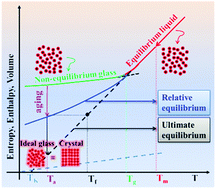The very long-term physical aging of glassy polymers
Abstract
The thermodynamic behavior of glasses well below the glass transition temperature (Tg) is scarcely explored due to the long time scales required for such investigation. Here, we characterize the thermodynamic state of several polymer glasses aged for about 30 years at room temperature, that is, at more than 100 K below their respective Tg(s). To this aim we employ differential scanning calorimetry (DSC), which, via specific heat, allows characterizing the enthalpy attained after a certain aging protocol and the way the glass with such an enthalpy devitrifies when heated. We complement these results with extensive DSC studies on these polymers aged under the same conditions of temperature for time scales ranging from minutes to months. The main outcome of the present work is that these polymers aged under these conditions reach a plateau in the enthalpy with partial enthalpy recovery and devitrify well below Tg. This result provides compelling evidence for the existence of a fast mechanism of equilibrium recovery, beyond the standard slow one in proximity of Tg. The analogy with other kinds of glasses is highlighted, stigmatizing the universality of such behavior. Finally, the way the fast mechanism of equilibrium recovery could be exploited to obtain glasses with a low energy state is discussed.

- This article is part of the themed collection: 2018 PCCP HOT Articles


 Please wait while we load your content...
Please wait while we load your content...